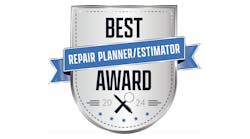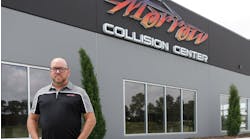Content brought to you by ABRN. To subscribe, click here.
From parts and pricing pressures, to technician shortages, ADAS calibrations and insurer relationships, MSOs face a variety of challenges. ABRN this year convened an “MSO Roundtable,” bringing together a panel of regional MSOs to discuss some of these topics. Here are highlights from the discussion (with responses edited for length or clarity), which took place with the following panelists:
- William Bray is a third-generation partner and general manager of three Fix Auto USA franchise locations in Oregon.
- Devin Fischer is a managing partner for Fischer Body Shop, which has three locations in Missouri.
- Stephen Kendrick Jr. is the CEO of Kendrick Paint and Body Shop, which operates seven shops in Georgia and South Carolina.
- Andrew Suggs is the president of European Collision Repair, which operates four shops in Tennessee and Georgia.
ABRN: Let’s start by talking about what you’re doing differently within your business in response to two of the recent challenges cited by collision repairers: Inflation and supply chain issues.
Fischer: I think the biggest thing for us is we’re spending a lot more time looking in different areas for parts, some places you normally didn’t think you’d ever look. The other day I ordered a headlight off of eBay because there wasn’t one anywhere in the country. We’re also more carefully verifying when we’re going to receive parts because sometimes you think you’re going to see them in a week, and it turns into a month.
Bray: We’ve ordered parts from eBay, Amazon, even Craigslist. We’ve found old stock lying around at dealers we’ve never heard of in states we don’t normally get parts from. Instead of ordering from the bigger players, you can find some parts at the smaller players in town that might not deliver but might have what you need, and we’re repairing more. If a technician says, ‘I need this part,’ we turn around and ask, ‘What if I can’t get it?’ All of a sudden, they look again and say, ‘Yeah, I can fix it.’ You have to look at things with new eyes because you might not actually be able to get that part. In terms of inflation, we just push really hard for labor rate increases right now.
Kendrick: It’s the same way here. We approached all our insurance partners for a rate increase to help out with the inflation. For the most part, most of them were pretty good about it. We still have a few that are still holding out. We also went back and looked at all our supplier agreements, and renegotiated contracts there.
ABRN: Vehicle calibrations and resets are becoming an increasing portion of total repair costs. How is your company handling this work?
Suggs: We don’t do any in-house. However, I bought the building next door, and we’re going to open up a separate calibration company. We did $1.7 million in calibration sublet last year as a company, so it only makes sense for us to do that. It’s just too much of a profit center to not jump on it, and the dealers are just so backed up.
Fischer: I’d love to have something like that. We do not have a local mobile person. Andrew, if you get that up and running, how about putting them across the country, like near us. That would save us a ton of time waiting for dealerships.
Kendrick: We haven’t found the value yet to create our own standalone facility. Right now, we’re fortunate to have a local company that we sublet to. They’re mobile and have quite a few technicians.
ABRN: How about your relationships with insurance companies. What’s working, what’s not?
Suggs: I don’t have any DRPs, so I don’t really know that side, but I do know it’s taking a lot longer for us without DRPs. It feels like we’re doing 85 percent of the work. With all the inputting and all the photos, it’s wearing my office down. We’ve actually had to add people to each office just to facilitate getting these claims handled.
Bray: Have you considered an administrative fee on every claim since you don’t have a contract agreeing to do things for no charge?
Suggs: We probably get that about 40 or 45 percent of the time. We charge a $250 admin fee. If it takes over four supplements, then it’s a $500 fee.
Bray: Good for you.
Fischer: One of my DRPs is Progressive, and I know a lot of people don’t care for them, but in my area, the program works amazingly. I have a network adjuster who is always here. We do the teardown, and we work together to write an estimate. It’s simple. I’d love to see that process with other companies. Have them actually come out and put a little effort into it instead of not coming out at all or coming out and writing an [incomplete] sheet, throwing it on your desk, and away they go.
Bray: Our two biggest DRPs are USAA and State Farm. They are both the most streamlined among those we work with. At the other end of the spectrum, another insurer has a DRP program, but they treat claims like a non-DRP program.
You’ll have a $4,000 job with seven or eight supplements. It’s absolutely ridiculous to go through that process. I told them, ‘There’s no benefit to me to be on the program. I expect ease of process, like USAA and State Farm offer, to stay on your program.’ They came back and said, ‘Maybe we can let go of [one requirement].’ So to me, that’s a step in the right direction if that comes to fruition. If you want a lower rate and other discounts, I need to have some benefit in processing in order to be efficient and make up for that.
ABRN: The tech shortage has long been an issue for this industry. What specifically is working for you in terms of recruiting, developing, or retaining the people you need?
Bray: In our market, technicians talk. As long as you are a good place to work, you’ll get a good reputation. Every employee has my personal cell phone number. When I have someone who leaves on good terms, I will stay in touch with them. On occasion, I’ll just text them out of the blue.
I just had a former painter’s helper who left on good terms text me and say, ‘I heard you have an opening at one of your locations.’ He’s very interested in going to work over there. Some owners say, ‘If someone quits, I’m never hiring them again.’ But some of my best people have gone somewhere else for a while, and then come back, and they then generally stay here. So, maintaining relationships helps.
Fischer: Seventeen or 18 years ago, we had one shop, and it was tough to work for. I thought there were plenty of people out there. I lost a lot of people. If I’d taken the time to develop them, I think I would have been in a little better spot than I am. Everybody’s different. You just have to develop them and work with them.
We’ve been taking a lot of time to maybe stick with people a little longer than we might have in the past, to try to get them the correct training, to get them to buy into how we do things. It’s worked over the last several years. All three shops are staffed really well right now.
Kendrick: As he said, it’s taking time with the people we’ve got bringing up individuals who want to take part in the industry and investing in them, and individuals who have quit. I’ve sometimes hired them back two or three or four times, giving them multiple chances.
When the pandemic hit and a lot of other states shut down, we started reaching out into some of these other states. We ended up flying some people in, showing them around and helping pay some moving expenses to have them relocate. For the most part, they stuck, though some have gone their own way, but it’s worked out pretty well.
Suggs: That’s actually one of our biggest objectives this year is to become more aggressive with recruiting technicians from other areas. Honestly, California is probably our biggest area we’re going to try to go after, just because there are so many technicians there. The labor pool is fantastic. It’s amazing how many responses we get just from doing some geofenced advertising around a handful of decent shops.
ABRN: Let’s close with what you see as the biggest challenge facing your company in the next 12 to 24 months, and what you foresee doing to address it?
Kendrick: One of the things we’re going to be working on for the next few years is our people. We want to make sure we don’t have an MSO or corporate type of experience for our people. We want them to feel more like a family type of experience. A local business. We’re always cooking out.
I’m always in the shop. I’m talking to them, shaking their hands about every single day. There’s somebody at each shop who probably has 30 years of experience at Kendrick. We also have a lot of people who have been with us 10 or 20 years, so having them there helps with that family-type feel as well.
We’ve also started an in-house apprenticeship program, where we can bring somebody in to work with a seasoned technician. They don’t have to come in with any skills at all. They learn from the bottom up. We’ve graduated a few that way. It takes a few years for a return, but it’s one of the things we’re working toward.
Bray: The biggest challenge is probably maintaining all the training requirements for our certifications and capacity limitations. It doesn’t matter who the carriers call in our market. If they have a tow-in, they are calling three or four shops and getting rejected over and over, so they’re all demanding we take their cars or they’re going to cut us off. Maintaining those DRP relationships that are good is going to be a challenge.
Fischer: Finding good techs, and trying to think outside the box of where to find them, is going to be a big thing for us over the next few years. When I first started, I could find a tech at a tech school any day. Do they always work out? Not necessarily, but at least you could find one. But now, good luck finding anybody who wants to put the time and effort into learning to be a good tech. I really think that’s going to be our biggest struggle over the next few years.
Suggs: I think the biggest challenge that I’m going to face personally, because we are so busy, is keeping our SOPs on track. We had a similar problem in 2017 and 2018 when we were really busy, and we lost sight of the process. When that breaks down, it creates a whole lot of problems.
My biggest challenge over the last year was employee burn-out. We’ve had three record years in a row. We have focused on limiting technicians to 47 clock hours a week. We won’t let them work any more than that. It’s not worth it.
Looking at several years of data, we are more profitable the two or three weeks after a 3-day weekend than we were at any other time of the year. So how do you replicate that? How do you get them that downtime to get away, to clear their head?
The only way is to limit a guy and have him enjoy his weekend, so we try to push Monday through Thursday, to really go hard at it, and Friday by noon or 3 p.m. all my technicians are gone, so they get a longer weekend.
It’s also a benefit. You’re able to pick up some new technicians when you tell them, ‘We hump it Monday through Thursday, and Friday at noon, we’re ready to shut it down.’




